British clog maker showcases heritage craft from Sheffield to Morris dancers across the world
When it comes to clogs, most people think of a Dutch girl standing in front of a windmill, says Simon Brock. Simon knows a lot about clogs and will have made around 200 pairs by the end of the year. British clogs, that is, not the Dutch girl type.
“In the low countries you get those kind of clogs which are entirely a closed wooden shoe, although I think you’re supposed to wear a slip-on leather under-shoe – they are overshoes to get you through the mud,” he says. The Belgians, the French and Scandinavians all have their own style of clogs. “But what makes British clogs almost unique – almost because I think in Galicia they had the same sort of thing – is a wooden sole and a fully enclosed leather upper.”
Advertisement
Hide AdAdvertisement
Hide AdHe can make a pair of British clogs in a day at his workshop in the Shalesmoor area of Sheffield, where, in Victorian times, several bootmakers would have toiled. Simon is one of a handful of clog makers working on a commercial scale in the UK. Determined to keep the craft alive, he has spent the past decade learning the specific skills required by training with two remaining master clog makers.
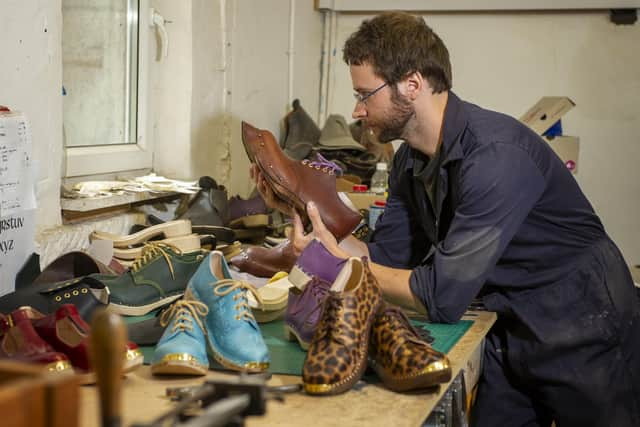

The lack of flexibility in the wood means the clogs have a distinctive upturned front sole. “All of the movement has to come from that action of rolling forward of the foot,” Simon says.
He starts with the soles, using sycamore which comes from National Trust forests north of Leeds, either as large rounds of trunk or as thick planks, cut especially for him by the foresters. He first uses a band saw to cut the cast, the shape of the shoe as seen from the side, then cuts the foot shape profile, smoothing the wood on the various contraptions in the workshop.
The next stage requires the use of huge clog knives to scoop out the sole and make it lighter. It sounds like a guillotine as he slices. He uses a hollower knife to shape the top of the sole to cradle the foot, then carves a ledge or rebate to nail the leather upper on to.
Advertisement
Hide AdAdvertisement
Hide AdBlack leather is the most popular but Simon has plenty of colours and types to choose from. The lasting up process involves placing the appropriate size of last upon the wooden sole and wet-forming the leather around it, tacking it in place and then, once dry, trimming the excess and finishing off with shining brass nails from France.
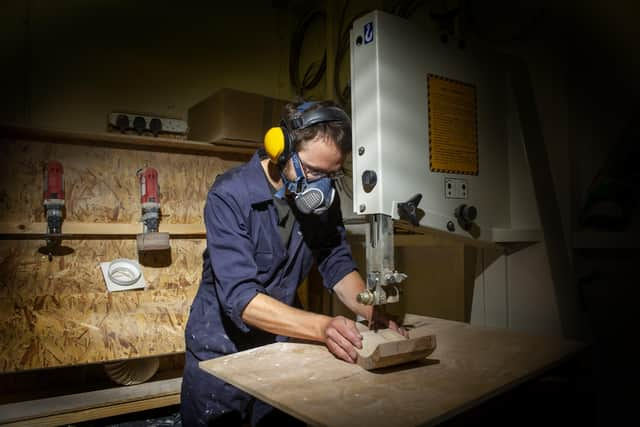

The beautiful wooden lasts, made specifically for crafting British clogs, were bought, along with other equipment, from retired Todmorden-based clog maker Rick Rybicki.
“His clogs have a very fine reputation,” Simon says. “After a bit of persuasion, he sold me the lot. These have got history – some are from the ’30s.”
Most of the clogs Simon makes are for Morris and step dancers. Morris dancing clogs have rubber on the sole but the ones for step dancing, which is a little like tap dancing, do not.
Advertisement
Hide AdAdvertisement
Hide Ad“If you wear a bare wooden sole outside, you’d fall over pretty quickly, lethal really,” he says. Increasingly, he makes clogs for general use, and adds a thick rubber sole with a good grip.
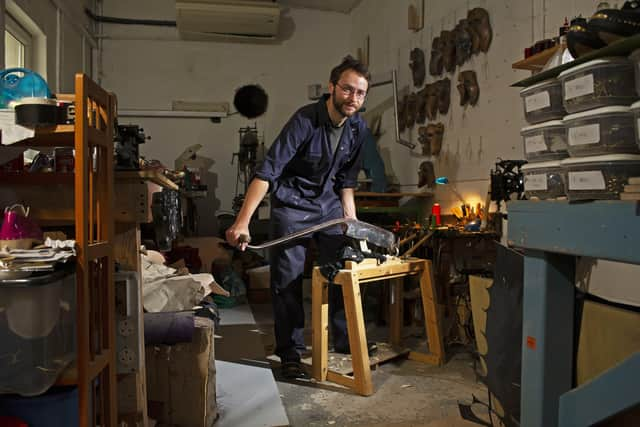

It was through Morris dancing that Simon, 34, discovered clog making. Originally from Barnsley, his father was a college lecturer and his mother worked in a school. “I don’t think I really knew what I did want to do with my life but I knew what I didn’t want to do, which was work in an office, or be a teacher,” he says.
So, after A-levels at Penistone Grammar School, he went to Leeds Art College to study for a two-year HND course in furniture making and then found a job in Knaresborough at T L Phelps Fine Furniture Restoration, where he stayed for three years working on commissions for the National Trust and English Heritage. One of his projects involved restoring the cupboards at the Rotunda Museum in Scarborough. “That was really interesting,” says Simon.
One fine day in Knaresborough, he came across Harrogate-based Morris team Flag & Bone Gang. “I saw them dancing in the market square,” he says. “I thought, yeah, that looks all right, so I went and said, ‘I really enjoyed that’, and they obviously spied someone who was fairly young – what would I have been then, 21? I was into folk music anyway, but I don’t know why now, looking back. I always thought Morris dancing was not for me. Anyway, they took me to the pub and I woke up the following morning with a sore head thinking, did I just join the Morris team? It was like the King’s shilling, but they were such a great bunch. I’m still friends with them all now, though I’m not really active in the team any more.”
Advertisement
Hide AdAdvertisement
Hide AdRestless, at 23, he left for Canada, where he worked on a sheep farm for six months. “It seemed like a good idea at the time,” he says. “It was a great adventure. I learned how to shear. But there’s not so much Morris dancing in Canada and it did make me realise the things that I like about this country and what’s important – family, pubs, Morris dancing.”
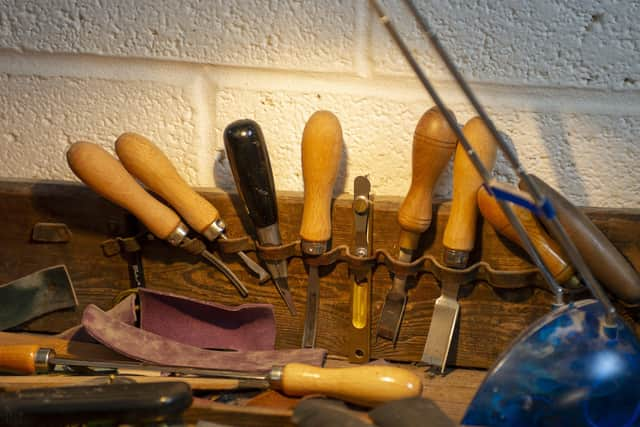

He returned to Barnsley, moved back in with his parents, worked in cafes, and then, in 2010, on a visit to Whitby Folk Festival, he met North Wales-based clog maker Trefor Owen, who had a stall there. Simon says: “I was intrigued by the objects, particularly as they had a wooden sole, with my furniture making background.” He asked Trefor how he made them.
“It’s amazing that he said it, because it did change the course of my life, but he said ‘come to Wales and stay over for a week and I’ll show you how it’s done.’”
Simon did just that, beginning an apprenticeship that has lasted, on and off, for 10 years. He taught himself leather working, which diverted him for a few years, then returned to clog making (he also has qualifications in timber technology). He sold his first pair in 2018. Last year, he won two awards from the Heritage Crafts Association – the HCA/Marsh Endangered Craft Award and the HCA/Arts Society Heritage Crafts bursary – which enabled him to train in the hand-cutting of clog soles with Jeremy Atkinson in Herefordshire.
Advertisement
Hide AdAdvertisement
Hide AdSimon now dances as a member of Handsworth Sword Dancers and lives in Walkley with his wife, Catherine, an environmental auditor. She is also a Morris dancer and they met in Windsor at a weekend event hosted by the Berkshire Bedlam. “I was dressed as an East German athlete for some skit that we’d been doing and she was in this Victorian kind of corset and skirt garb,” Simon says. They married in 2017.
Simon’s clogs are in demand, with a six-month waiting list. Most are made to order and he exports to the US (incidentally, today is the first National Day of Clogging in the US, and International Day of Clog Dancing worldwide), Australia, Russia and wherever people dance in clogs. He has ready-made stock he takes to festivals and clog dancing competitions but, of course, all that is now on hold.
His favourites are a pair of striking brown and white cow hide clogs he made recently. They cost £150, although most start at £110 for an adult style, which is astonishing value, considering the time, skill and materials involved.
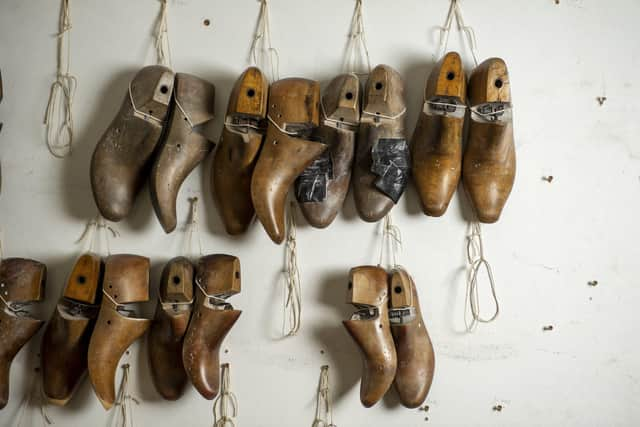

People send their clogs in for re-wooding, too, putting their existing leather upper onto a new sole. “The leather soles wear down but the leather uppers might have some significant sentimental value,” Simon says. “Clogs are almost infinitely reparable and recyclable.”
Simon Brock, clog maker and leatherworker, Simonbrock.co.uk
Stephanie Smith Instagram @yorkshirestyleQ
Advertisement
Hide AdAdvertisement
Hide AdFor more stories from the YP Magazine and The Yorkshire Post features team, visit the YP Magazine Facebook page.
Editor’s note: first and foremost - and rarely have I written down these words with more sincerity - I hope this finds you well.
Almost certainly you are here because you value the quality and the integrity of the journalism produced by The Yorkshire Post’s journalists - almost all of which live alongside you in Yorkshire, spending the wages they earn with Yorkshire businesses - who last year took this title to the industry watchdog’s Most Trusted Newspaper in Britain accolade.
And that is why I must make an urgent request of you: as advertising revenue declines, your support becomes evermore crucial to the maintenance of the journalistic standards expected of The Yorkshire Post. If you can, safely, please buy a paper or take up a subscription. We want to continue to make you proud of Yorkshire’s National Newspaper but we are going to need your help.
Advertisement
Hide AdAdvertisement
Hide AdPostal subscription copies can be ordered by calling 0330 4030066 or by emailing [email protected]. Vouchers, to be exchanged at retail sales outlets - our newsagents need you, too - can be subscribed to by contacting subscriptions on 0330 1235950 or by visiting www.localsubsplus.co.uk where you should select The Yorkshire Post from the list of titles available.
If you want to help right now, download our tablet app from the App / Play Stores. Every contribution you make helps to provide this county with the best regional journalism in the country.
Sincerely. Thank you.
James Mitchinson
Editor
Comment Guidelines
National World encourages reader discussion on our stories. User feedback, insights and back-and-forth exchanges add a rich layer of context to reporting. Please review our Community Guidelines before commenting.